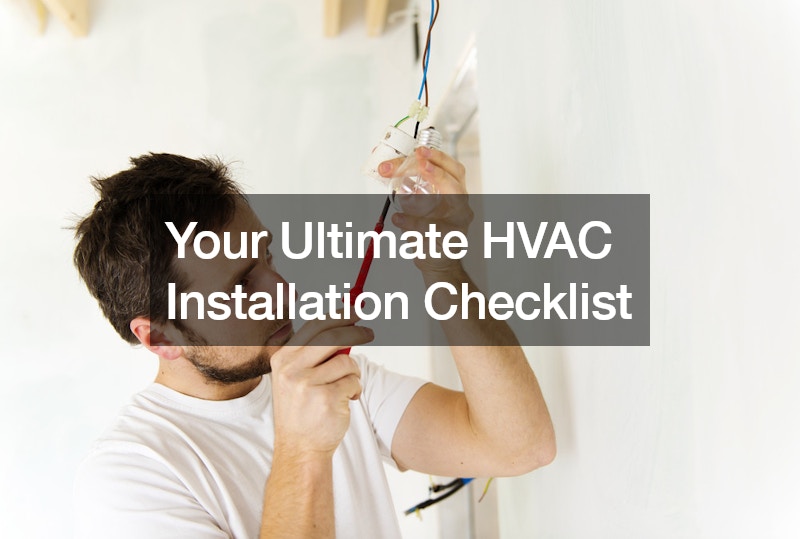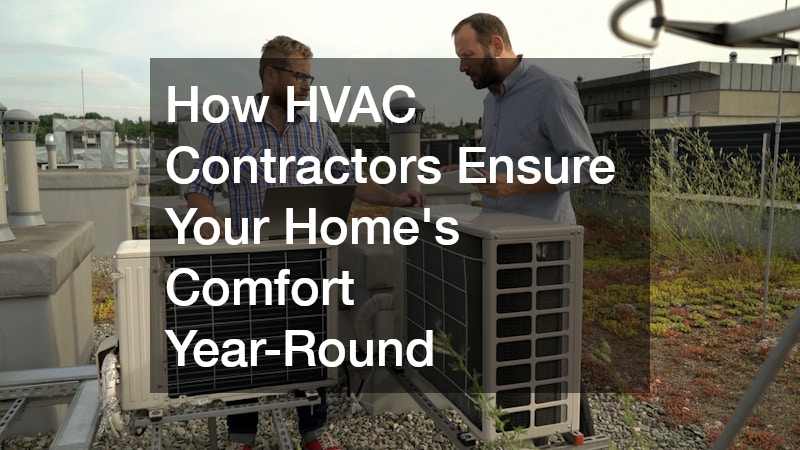An HVAC installation checklist is essential for ensuring that your heating, ventilation, and air conditioning system is properly installed and running efficiently. In this article, we will go through 15 important points to consider when installing an HVAC system.
1. Sizing
When it comes to HVAC installation, sizing is crucial to ensure that the system functions optimally. Determining the right size involves evaluating the square footage of the space to be heated and cooled. Calculating load requirements is a key part of your HVAC installation checklist and helps in determining the necessary capacity to maintain a comfortable indoor environment.
Proper sizing prevents the HVAC system from overworking, which can lead to increased energy consumption and frequent repairs. It is essential to consult with a professional HVAC contractor to accurately assess the sizing requirements for your specific needs. By following a detailed sizing process, you can ensure that your HVAC system operates efficiently for years to come.
For a successful installation, the sizing process should account for factors such as insulation levels, window efficiency, and climate considerations. These variables play a significant role in determining the appropriate size of the HVAC system to meet your heating and cooling demands.
2. Ductwork
Inspecting existing ductwork is a critical step in the HVAC installation checklist to identify any leaks or blockages that could affect system performance. Sealing and insulating ducts help in maintaining proper airflow and energy efficiency. Properly sealed ductwork prevents air leaks and ensures that conditioned air reaches every room in your home.
Efficient ductwork is essential for distributing heated or cooled air effectively throughout the building. HVAC surge protection should be considered to safeguard the system from power fluctuations that can damage components. Working with experienced HVAC contractors ensures that your ductwork is installed correctly and functions optimally.
When installing a mini split HVAC system, ductwork may not be required, making it a versatile option for various applications. A mini split HVAC installation offers energy-efficient heating and air conditioning solutions for homes without existing ductwork. Consulting with a local HVAC company can help you determine the best ductwork options for your specific needs.

3. Equipment Selection
Picking your system is next on your HVAC installation checklist. Choosing the right HVAC system is crucial for optimal performance and energy efficiency. Different factors such as climate, building size, and budget should be considered when selecting equipment. Energy-efficient HVAC systems help in reducing utility costs and environmental impact while providing reliable heating and cooling.
Selecting energy-efficient equipment ensures that your HVAC system meets industry standards for performance and sustainability. Working with HVAC contractors who offer a range of equipment options can help you choose the best system for your specific requirements. Local HVAC installation professionals can provide guidance on selecting the most suitable equipment for your home.
Regular HVAC maintenance is essential for prolonging the lifespan of your system and preventing costly repairs. By scheduling routine maintenance with a reputable HVAC contractor, you can ensure that your system operates efficiently and effectively. HVAC surge protection can also be installed to safeguard your equipment from power surges that can cause damage.
4. Permits and Regulations
Understanding local building codes and regulations is essential is a key thing on your HVAC installation checklist. Do this before starting an HVAC installation project. Obtaining necessary permits ensures that the installation complies with safety and environmental standards. Local HVAC contractors are familiar with building codes and can assist you in obtaining the required permits for your project.
Failure to comply with regulations can result in fines and delays in completing the installation. Working with licensed HVAC contractors who are knowledgeable about local regulations guarantees that your installation is done according to industry standards. By following permit requirements, you can avoid legal issues and ensure the safety and efficiency of your HVAC system.
Budgeting for permits and regulatory expenses is essential when planning an HVAC installation project. Factor in permit costs and potential regulatory fees when setting a realistic budget for your project. Local HVAC installation companies can provide detailed cost estimates that consider permit expenses and other regulatory requirements.
5. Budgeting
Setting a realistic budget for your HVAC installation project is crucial for ensuring that the process runs smoothly. Factor in all costs associated with equipment, labor, permits, and any additional expenses. Working with HVAC contractors who offer transparent pricing can help you stay within your budget while getting quality service.
It is important to account for potential additional costs that may arise during the installation process. Unexpected issues or upgrades could impact the overall cost of the project, so having a contingency fund is advisable. Discussing budget concerns with your HVAC contractor can help you plan accordingly and avoid financial surprises.
By planning your budget meticulously and consulting with local HVAC companies, you can ensure that your installation project stays on track financially. Comparing quotes from multiple HVAC contractors can help you determine the most cost-effective solution for your heating and cooling needs. Be sure to consider long-term savings and energy efficiency when budgeting for your HVAC system.
6. Contractor Selection
Researching and interviewing HVAC contractors is essential for finding a reliable and skilled professional for your installation project. Check credentials, experience, and customer reviews to evaluate potential contractors. Choosing an experienced HVAC contractor ensures that your system is installed correctly and functions efficiently.
Checking references and reviews can give you insight into the contractor’s reputation and service quality. Ask for referrals from friends or family who have worked with HVAC contractors in the past. Local HVAC installation professionals are familiar with regional climate conditions and can recommend the best systems for your specific needs.
Working with a reputable HVAC contractor provides peace of mind that your installation will be completed to industry standards. Local HVAC companies offer personalized service and ongoing support for maintaining your system. By selecting a qualified HVAC contractor, you can rest assured that your heating and air conditioning needs are in good hands.

7. Pre-Installation Inspection
Assessing existing conditions before HVAC installation is essential to identify potential issues that could affect system performance. Inspect the building’s layout, ventilation, and insulation to determine the best installation approach. Addressing any deficiencies in advance helps in ensuring a smooth and successful installation process.
It is crucial to assess the suitability of the installation location and make any necessary adjustments before starting the project. HVAC surge protection can be installed to safeguard your system from power fluctuations that could cause damage. Consulting with experienced HVAC contractors can help you address pre-installation concerns and make necessary preparations.
Proper planning and thorough inspection before installation are key to preventing delays and complications during the project. By conducting a pre-installation inspection, you can anticipate potential challenges and take proactive measures to address them. Local HVAC installation professionals can provide guidance on preparing your space for a seamless installation process.
8. Installation Process
Setting up equipment is a crucial step in the HVAC installation checklist to ensure that all components are properly installed. Professional HVAC contractors have the expertise to handle complex installations and ensure accurate placement of equipment. Connecting ductwork efficiently is essential for maintaining airflow and system performance.
Proper installation of equipment helps in maximizing energy efficiency and preventing issues that could impact system operation. HVAC surge protection can be integrated into the installation to protect the system from electrical damage. Working with experienced HVAC contractors guarantees that your system is installed correctly and functions optimally.
During the installation process, it is important to follow manufacturer guidelines and industry best practices for setting up equipment. HVAC contractors use specialized tools and techniques to ensure that each component is installed securely and operates efficiently. By partnering with professional HVAC installers, you can have confidence in the quality of your installation.
9. Testing and Balancing
Checking for leaks in the HVAC system is essential to prevent energy loss and ensure optimal performance. Conduct thorough testing to identify any leaks in ductwork or equipment connections. Balancing airflow throughout the system helps in maintaining consistent temperature levels and improving comfort.
Balanced airflow is key to maximizing energy efficiency and minimizing strain on the HVAC system. Regular maintenance and testing of the system can help in detecting and addressing issues before they escalate. HVAC surge protection can be installed to shield your system from power surges that could cause damage.
10. System Start-Up
Initiating the HVAC system involves powering up the equipment and testing its operation in heating and cooling modes. Verify that all components are functioning correctly and respond to temperature adjustments. Testing the system in both modes helps in identifying any issues that may affect performance.
During system start-up, check that the thermostat is calibrated correctly and communicates with the HVAC system. Make adjustments as needed to ensure that the system maintains the desired temperature levels. HVAC surge protection can be added to safeguard the system from electrical damage.

11. Maintenance Plan
Keeping your system working is a key part of your HVAC installation checklist. Establishing a regular maintenance schedule is essential for prolonging the lifespan of your HVAC system and preventing costly repairs. Change filters and clean components to maintain efficient operation and indoor air quality. Developing a maintenance plan with your HVAC contractor ensures that your system is well-maintained.
Regular maintenance helps in identifying and addressing issues before they escalate, reducing the risk of system breakdowns. HVAC repairs should be handled promptly to prevent further damage and ensure uninterrupted operation. Consult with your HVAC contractor for personalized maintenance recommendations based on your system’s needs.
Changing filters and cleaning components are simple maintenance tasks that can improve system performance and indoor air quality. By following a maintenance plan recommended by your HVAC contractor, you can extend the lifespan of your system and avoid costly repairs. Regular maintenance is key to ensuring that your HVAC system operates efficiently year-round.
12. Warranty Information
Understanding warranty coverage is essential for protecting your investment in HVAC equipment. Review the terms and conditions of the warranty to know what is included and excluded. Registering your equipment with the manufacturer ensures that you can take advantage of warranty benefits in case of issues.
Registering your HVAC equipment promptly can expedite the warranty claims process and provide you with peace of mind. It is important to keep warranty documents and proof of purchase in a safe place for easy reference. Work with your HVAC contractor to understand warranty coverage and ensure that you meet all requirements.
13. Energy Efficiency
Maximizing energy savings is a key consideration in HVAC installation to reduce utility costs and environmental impact. Utilize programmable thermostats to optimize energy usage and maintain comfort levels. Working with HVAC contractors who prioritize energy efficiency helps in selecting systems that meet your efficiency goals.
Programmable thermostats allow you to set schedules for heating and cooling based on your daily routines. Adjusting temperature settings when the space is unoccupied can save energy and reduce utility bills. HVAC contractors can recommend energy-efficient solutions that align with your sustainability objectives.

14. Safety Considerations
Ventilation is next on your HVAC installation checklist. Ensuring proper ventilation is essential for maintaining indoor air quality and preventing health issues. Test carbon monoxide detectors to confirm they are functioning correctly and provide adequate protection. HVAC surge protection can safeguard your system from power surges that could pose safety risks.
Maintaining proper ventilation in your home helps in reducing indoor pollutants and ensuring fresh air circulation. Regularly inspecting and testing carbon monoxide detectors is crucial for detecting any hazardous levels in the air. Consult with HVAC professionals for guidance on ventilation and safety measures in your home.
15. Final Inspection
Hiring a professional inspector for a final inspection is essential to confirm that the HVAC system is installed correctly. It should be the final thing on your HVAC installation checklist. Address any deficiencies identified during the inspection to ensure optimal system performance. Final inspections provide assurance that your system meets industry standards and operates efficiently.
Professional inspectors evaluate the HVAC system to ensure that all components are installed according to manufacturer guidelines. Addressing any deficiencies promptly helps in preventing issues that could affect system operation. HVAC contractors can assist in resolving any identified deficiencies and optimizing system performance.
By following this comprehensive HVAC installation checklist, you can ensure that your system is installed correctly and operating at its best efficiency. Remember to consult with professionals and follow all safety guidelines throughout the process.



